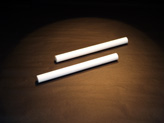MACOR® Machining Specifications
Technical information about the processing of MACOR®
Related topics and pages
- MACOR® (Machinable Glass Ceramic (MGC))
General Information
Essential factors for the successful processing  of MACOR® are proper machining speeds and the selection of a suitable coolant. The glass-ceramic can be processed with conventional HSS tools, although we recommend using carbide tools for more extended wear. Further, we recommend using water-soluble coolants designed for sawing and grinding glass or ceramics. Post-firing after machining is not necessary. On the right, you find typical values for the machining of MACOR®.
of MACOR® are proper machining speeds and the selection of a suitable coolant. The glass-ceramic can be processed with conventional HSS tools, although we recommend using carbide tools for more extended wear. Further, we recommend using water-soluble coolants designed for sawing and grinding glass or ceramics. Post-firing after machining is not necessary. On the right, you find typical values for the machining of MACOR®.
Processing Parameters
Sawing
- Carbide-grit blade
- Alternative: silicon carbide or diamond cut-off wheel
- Band speed: approximately 30.5 m/min.
Turning
- Cutting speed: approximately 9–15 m/min.
- Feed rate: approximately 0.05–0.13 mm/round
- Depth of cut: approximately 3.8–6.4 mm
Milling
- Cutting speed: approximately 6.1–10.7 m/min.
- Chip load approximately 0.002 ipt
- Depth of cut: approximately 3.8–5.1 mm
Drilling
Drill size |
Spindle Speed |
Feed rate
|
|---|---|---|
| approx. 6.4 | 300 | 0.13 |
| approx. 12.7 | 250 | 0.18 |
| approx. 19.0 | 200 | 0.25 |
| approx. 25.4 | 100 | 0.30 |
| approx. 50.8 | 50 | 0.38 |
Tapping
- Clearance holes are approximately 0.2–0.3 mm larger than those used for metals
- Chamfer both ends of the hole
- Run the tap in one direction only
(Do not turn the tap back and forth.) - Continuously flush with water or coolant to remove chips and dust
Grinding
- Use diamond, silicon carbide, or aluminum oxide grinding wheels
Polishing
- Start with loose 400-grit silicon carbide on a steel wheel
- You can do final polishing with cerium oxide or alumina on a polishing pad for glass or ceramics.
*We assume no liability for all processing details mentioned here. Errors are possible and remain reserved.
All data and specifications given are average guide values and are not guaranteed. Moreover, please consider the “Notes on Specifications”.
© 1994 – 2025 Präzisions Glas & Optik GmbH
Last update: May 21, 2024


